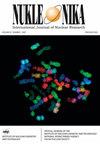等离子体技术去除废气中的氮氧化物
IF 0.3
4区 物理与天体物理
Q4 CHEMISTRY, INORGANIC & NUCLEAR
引用次数: 4
摘要
摘要船用柴油机的运行会产生大量的硫和氮氧化物排放。它引起了全世界的注意,并出台了有关有害排放的法规。阐述了几种解决办法;然而,SOx和NOx的排放控制需要在分离的装置中实现两个不同的过程,这是有问题的,因为船上的空间有限,总体成本高。因此,采用电子束烟气处理(EBFGT)工艺来确保船用柴油废气问题的解决。这种新的解决方案结合了两个主要过程:首先用电子束照射烟气,使NO和SO2氧化;第二阶段是湿式洗涤,以高效地去除这两种污染物。实验室试验表明,该工艺可以有效地去除柴油机尾气中的SO2和NOx。测试了三种不同氧化剂(NaClO、NaClO2和NaClO3)的吸收溶液的不同组成。当海水-NaClO2-NaOH用作10.9kGy剂量的洗涤器溶液时,获得了最高的NOx去除效率(>96%)。该工艺在拉脱维亚里加造船厂的实际海上条件下进行了进一步测试。在5.5kGy的剂量下,去除了超过45%的NOx,相当于4800 Nm3/h的船舶排放废气。该工厂的运行是第一个在实际条件下检验混合电子束技术的案例。考虑到实验条件,与实验室试验取得了良好的一致性。里加船厂的研究结果为该技术在大型货船排放控制中的应用提供了宝贵的信息。本文章由计算机程序翻译,如有差异,请以英文原文为准。
Plasma technology to remove NOx from off-gases
Abstract Operation of marine diesel engines causes significant emission of sulphur and nitrogen oxides. It was noticed worldwide and the regulations concerning harmful emissions were introduced. There were several solutions elaborated; however, emission control for both SOx and NOx requires two distinctive processes realized in separated devices, which is problematic due to limited space on ship board and high overall costs. Therefore, the electron beam flue gas treatment (EBFGT) process was adopted to ensure the abatement of the problem of marine diesel off-gases. This novel solution combines two main processes: first the flue gas is irradiated with electron beam where NO and SO2 are oxidized; the second stage is wet scrubbing to remove both pollutants with high efficiency. Laboratory tests showed that this process could be effectively applied to remove SO2 and NOx from diesel engine off-gases. Different compositions of absorbing solution with three different oxidants (NaClO, NaClO2 and NaClO3) were tested. The highest NOx removal efficiency (>96%) was obtained when seawater-NaClO2-NaOH was used as scrubber solution at 10.9 kGy dose. The process was further tested in real maritime conditions at Riga shipyard, Latvia. More than 45% NOx was removed at a 5.5 kGy dose, corresponding to 4800 Nm3/h off-gases arising from ship emission. The operation of the plant was the first case of examination of the hybrid electron beam technology in real conditions. Taking into account the experiment conditions, good agreement was obtained with laboratory tests. The results obtained in Riga shipyard provided valuable information for the application of this technology for control of large cargo ship emission.
求助全文
通过发布文献求助,成功后即可免费获取论文全文。
去求助
来源期刊

Nukleonika
物理-无机化学与核化学
CiteScore
2.00
自引率
0.00%
发文量
5
审稿时长
4-8 weeks
期刊介绍:
"Nukleonika" is an international peer-reviewed, scientific journal publishing original top quality papers on fundamental, experimental, applied and theoretical aspects of nuclear sciences.
The fields of research include:
radiochemistry, radiation measurements, application of radionuclides in various branches of science and technology, chemistry of f-block elements, radiation chemistry, radiation physics, activation analysis, nuclear medicine, radiobiology, radiation safety, nuclear industrial electronics, environmental protection, radioactive wastes, nuclear technologies in material and process engineering, radioisotope diagnostic methods of engineering objects, nuclear physics, nuclear reactors and nuclear power, reactor physics, nuclear safety, fuel cycle, reactor calculations, nuclear chemical engineering, nuclear fusion, plasma physics etc.
 求助内容:
求助内容: 应助结果提醒方式:
应助结果提醒方式:


